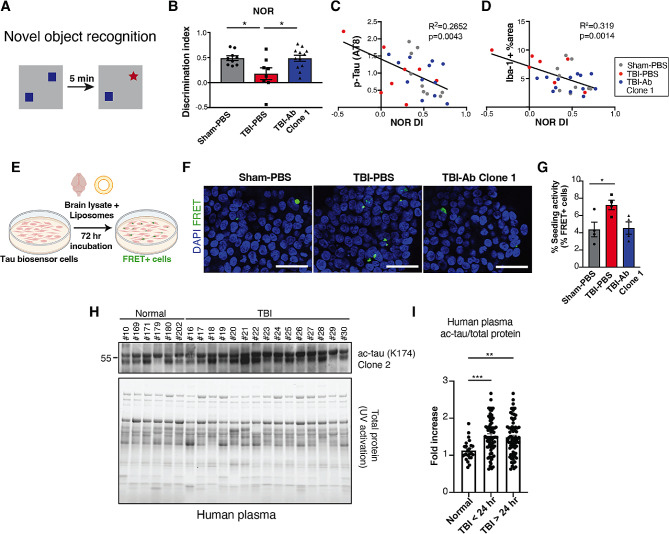Fig. 6.
Anti-ac-tauK174 treatment ameliorates behavioral impairments and reduces tau seeding in vitro. (A, B) Trauma-induced memory deficits were measured by novel object recognition (NOR) test. Three weeks post-injury mice were exposed to two identical objects, five minutes later one of the objects was replaced with a new object (A). Memory deficits were calculated by decrease in time spent with the novel object graphed as a discrimination index (B). *p< 0.05 by one-way ANOVA, Sidak’s multiple comparison test. n=9 (Sham-PBS), 8 (TBI-PBS), 12 (TBI-Ab Clone 1). (C, D) Pearson correlation analysis of NOR discrimination index (DI) and AT8-positive p-tau levels (by western blot) (C), and Iba-1 signal (D) (by western blot). n=12 per group. (E) Tau RD P301S FRET Biosensor cells were treated with brain lysates and liposomes, incubated for 72 hours, and imaged to assess tau seeding activity by measuring % FRET+ cells. (F, G) Representative immunocytochemistry staining (D) and quantification of % CFP/YFP FRET cells (E) after incubation with PS19 mouse lysate. *p<0.05 by one-way ANOVA, Tukey’s multiple comparison test. n=4 (Sham-PBS), 4 (TBI-PBS), 4 (TBI-Ab Clone 1). Scale bar: 50 µm. (H) Representative immunoblot of acetylated tau (K174) (Clone 2) in control (Normal) and TBI human plasma samples. (I) Quantification of plasma ac-tau (K174) levels normalized by total protein levels. The mean level of ac-tau (K174) was significantly higher in the TBI cohort at 24 h in comparison to the controls (1.57 ± 0.48 versus 1.13 ± 0.27,***p< 0.001). n=24 (normal), 44 (TBI),**p< 0.01 by one-way ANOVA, Dunnett’s multiple comparison test

